Introducing the Global X 1-3 Month T-Bill ETF (CLIP)
On June 21st, 2023, we listed the Global X 1-3 Month T-Bill ETF (CLIP) on NYSE stock exchange to provide investors with access to the front end of the treasury curve, addressing the growing need for a low-volatility investment option in today’s macroeconomic climate. With credit risk and interest rate risk looming as primary concerns for investors, the U.S. Treasury T-Bill ETF can be an ideal solution for both strategic and tactical allocation purposes. U.S. Treasuries’ AAA rating from major credit rating agencies can help limit credit risk, while the short-term nature of T-Bills helps mitigate interest rate risk.1 Additionally, the inverted yield curve can elevate the yield for short-term treasuries, making it an attractive choice for investors seeking a cash position with a yield. The ETF wrapper adds transparency and cost-effectiveness, further enhancing its appeal as an attractive investment option.
Key Takeaways
- Short-term treasuries are well positioned to tackle current market uncertainties and credit risk typically present in other fixed income securities, potentially making them a preferential alternative to cash.
- Short-term treasuries have outperformed longer dated treasuries, such as notes and bonds, while offering higher yields due to the inverted yield curve, a bond market dynamic that occurs when shorter-dated U.S. treasury yields are higher than longer-term treasury yields.2
- The Global X 1-3 Month T-Bill ETF (CLIP) offers access to the shorter-end of the U.S. treasury yield curve, with an expense ratio of half the average of passive, ultrashort bond ETFs at 0.07% versus 0.14%.3
Understanding Treasuries and How They Are Positioned in the Given Economic Conditions
U.S. Treasuries are widely acknowledged as securities with the lowest credit risk, boasting AAA ratings from esteemed rating agencies such as Moody’s, Fitch, and S&P.4 While Treasuries offer investors almost negligible credit risk, they do entail an additional form of risk: interest rate risk or duration risk. This risk arises due to their relatively lower coupon rates compared to other fixed income categories such as U.S. corporate debt, high-yield debt, and emerging market debt. The low credit risk associated with Treasuries translates into lower yields, making them more sensitive to fluctuations in interest rates.
To address interest rate risk, CLIP focuses on investing in the front end of the Treasury curve, thereby shortening the time to maturity. Bonds with shorter maturities expedite the return of the principal to investors, reducing long-term risk by allowing for earlier reinvestment of the returned principal. Consequently, short-term bonds such as T-Bills exhibit lower sensitivity to interest rate changes due to their shorter time to maturity. This strategic approach enables CLIP to invest in newer and potentially higher-yielding offerings in a rising rate environment, making it an attractive option for investors aiming to mitigate the impact of interest rate fluctuations on their fixed income investments while simultaneously reducing credit risk. The following illustration demonstrates the amplified influence of investing in Treasury maturities on total return, particularly during periods of interest rate volatility, such as the post-COVID era.
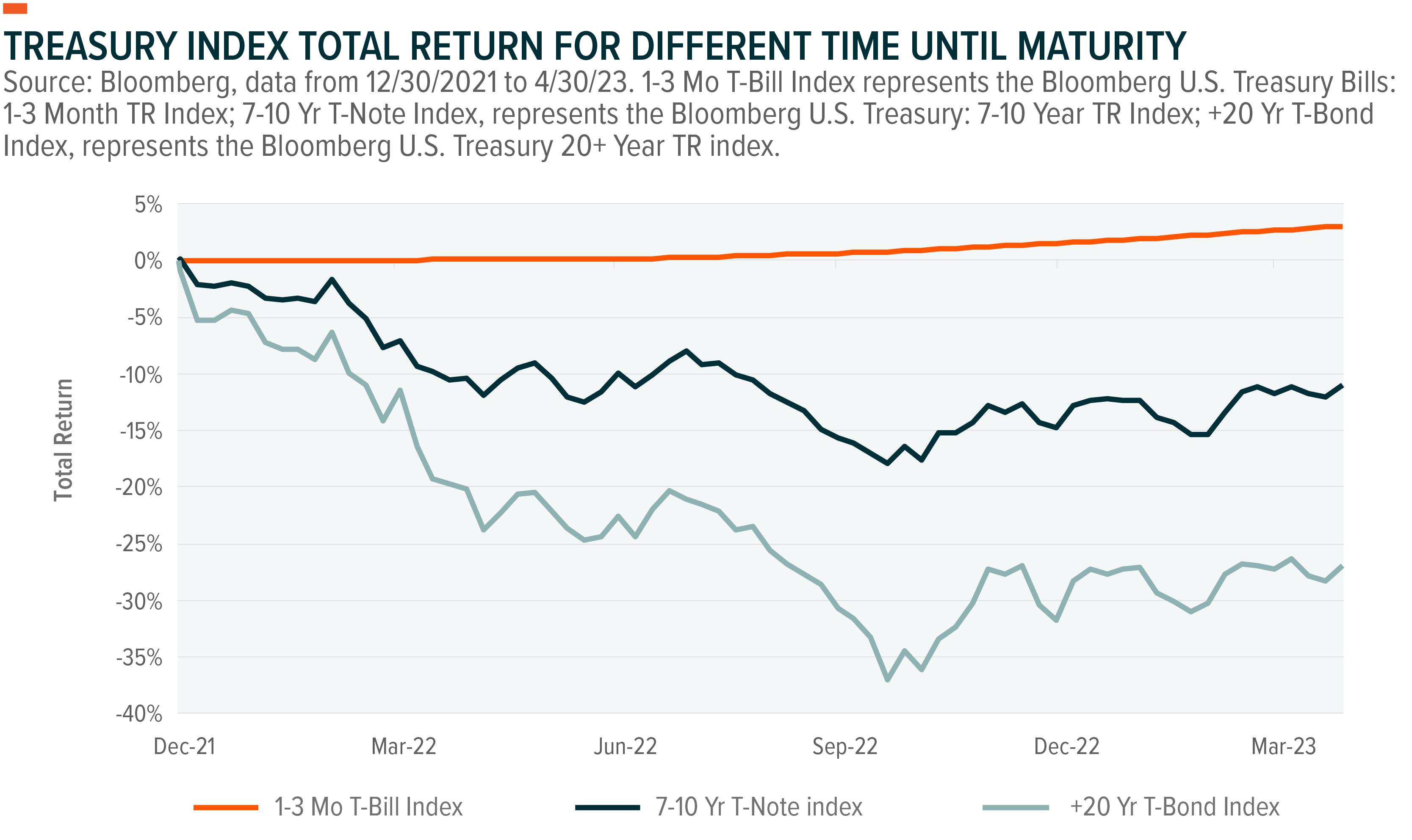
Past performance does not guarantee future results. One cannot invest directly in an index.
The Treasury curve is divided into Bills, Notes, and Bonds, each with a different coupon frequency, maturity, and risk profile. Global X’s offering focuses solely on T-Bills with a maturity between 1-3 months, also known as the front end of the curve.
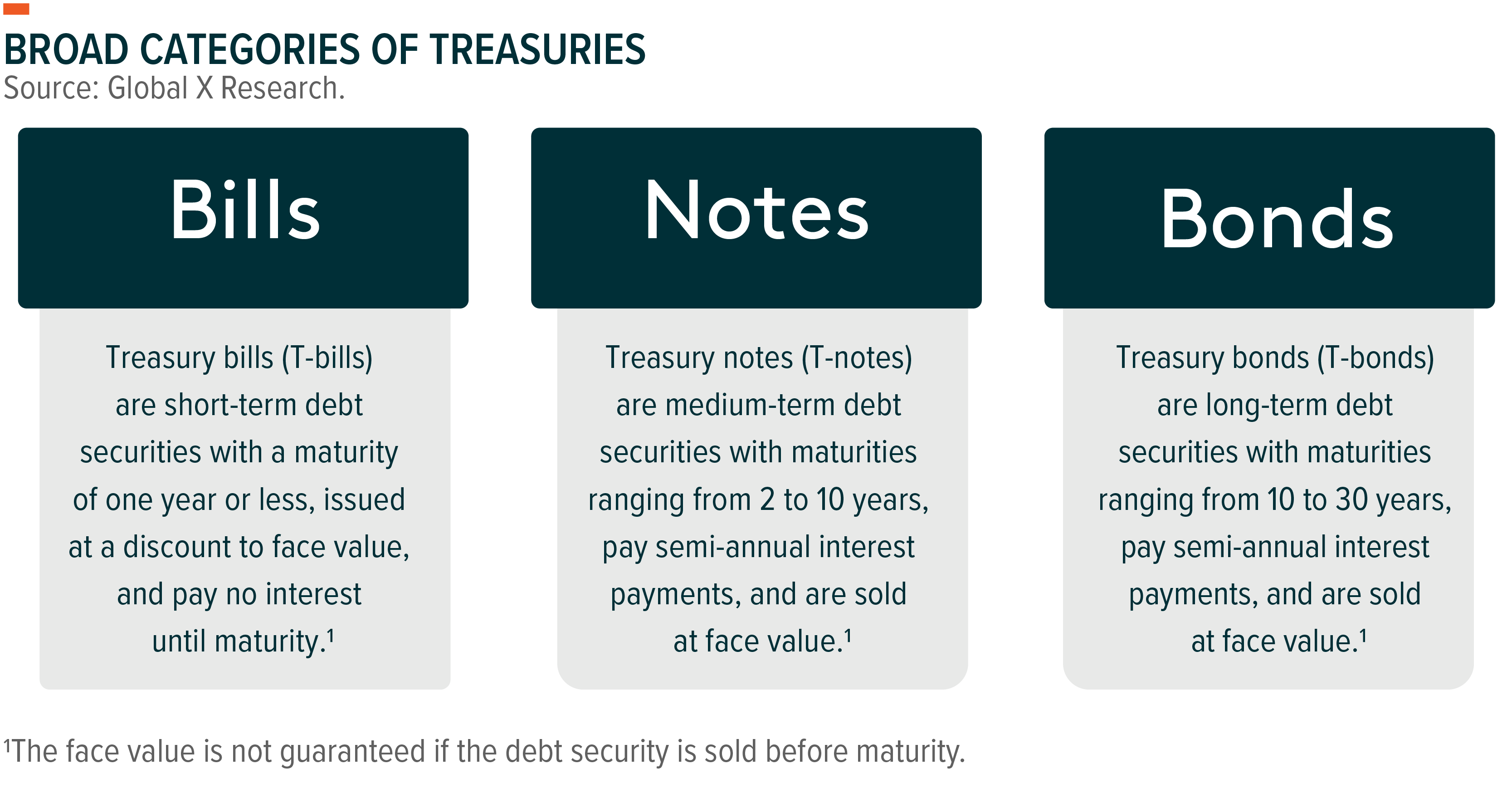
The Appeal of Short-Term Treasuries: Mitigating Credit Risk and Maximizing Yield in Uncertain Times
As the Federal Reserve embarked on its interest rate hike cycle to combat multi-decade high inflation, the Bloomberg U.S. Treasury Bills: 1-3 Months Yield to Worst 1-3 Index has displayed a high correlation with the Federal Funds Rate (FFR), as evidenced by the graph presented below. This indicates that short-term treasury bills are responsive to the interest rate adjustments by the Federal Reserve. Moreover, with the Federal Funds Rate currently at 5.25%, the highest level since the Great Recession, short-term treasury bills can present a compelling investment opportunity for risk-averse investors seeking yield with minimal exposure to credit or interest rate risks.5
Aside from the higher than historical yields generated at the front end of the treasury curve, this segment also boasts high liquidity. This is outlined by 1-to-3 month T-bills producing an expected available daily trading volume of $1.7 billion compared to the average of the rest of the treasury curve at $723 million, primarily due to the relatively short time until maturity. In addition, major entities in the U.S. and abroad use the front end as a liquidity or cash position such as banks, sovereign governments, corporations, and other entities and further solidifies its stability as an investment vehicle.6 Therefore, short-term treasury bills present a compelling option for investors looking for relatively stable and highly liquid investment opportunities amidst an environment of uncertain forward interest rates and inflation.
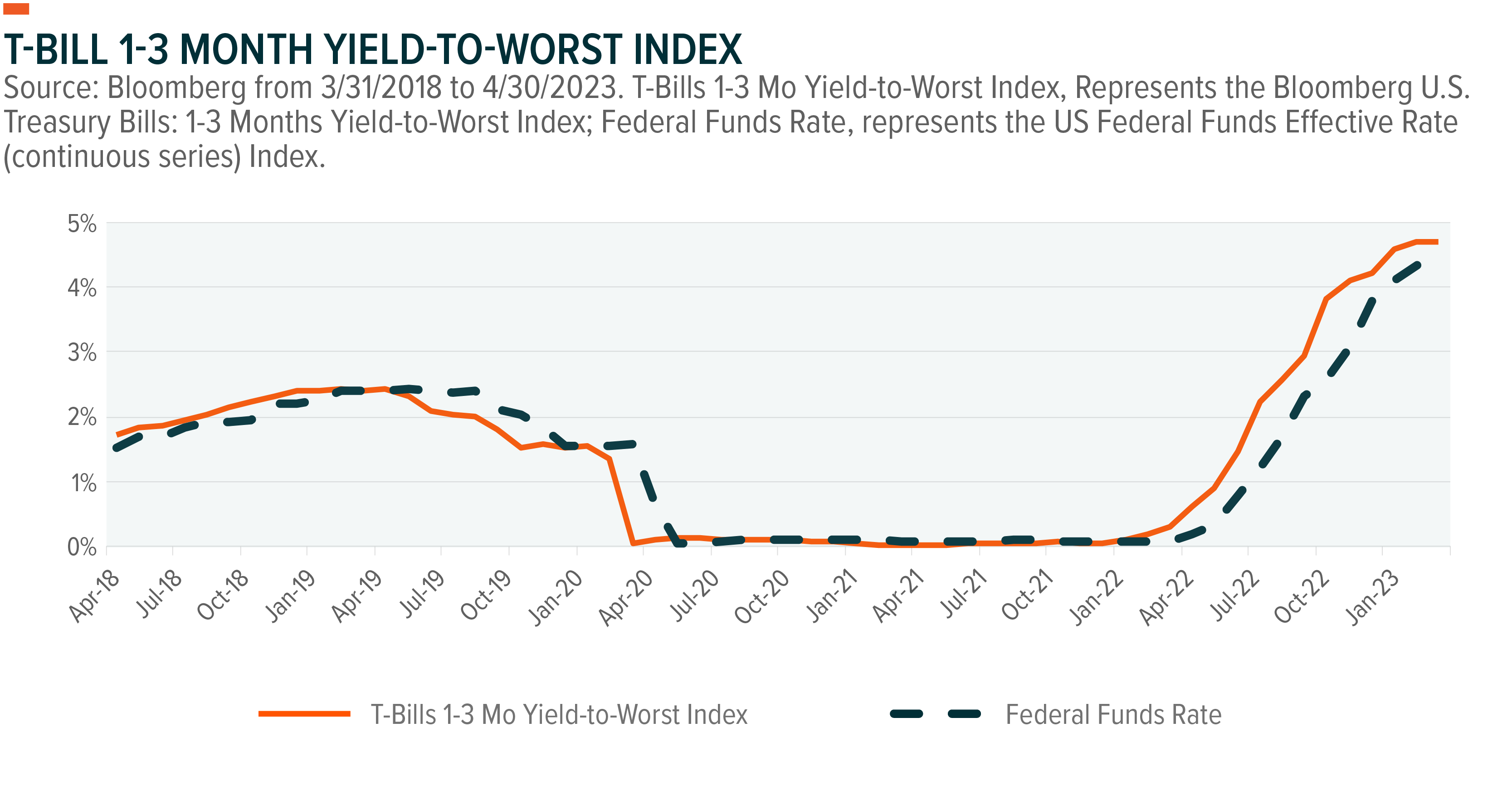
Past performance does not guarantee future results. One cannot invest directly in an index.
The current Treasury Curve reveals a divergence between the yields produced at the front-end versus the longer end of the curve, with the latter not offering yields exceeding the current inflation rate of 4.9%.7 This phenomenon can be attributed to the inverted yield curve, which has made short-term treasuries (T-bills) increasingly appealing to investors aiming to mitigate credit risk while maintaining a low-volatility and high-liquidity investment approach.
The lower yields on longer-term treasuries may indicate that investors anticipate lower future rates resulting from a lower long-term growth outlook, which could dampen equity returns in the short-term. Consequently, investors seeking to navigate the macroeconomic uncertainty may prefer the stability and a highly liquid feature of short-term treasuries until a clearer economic trajectory emerges.
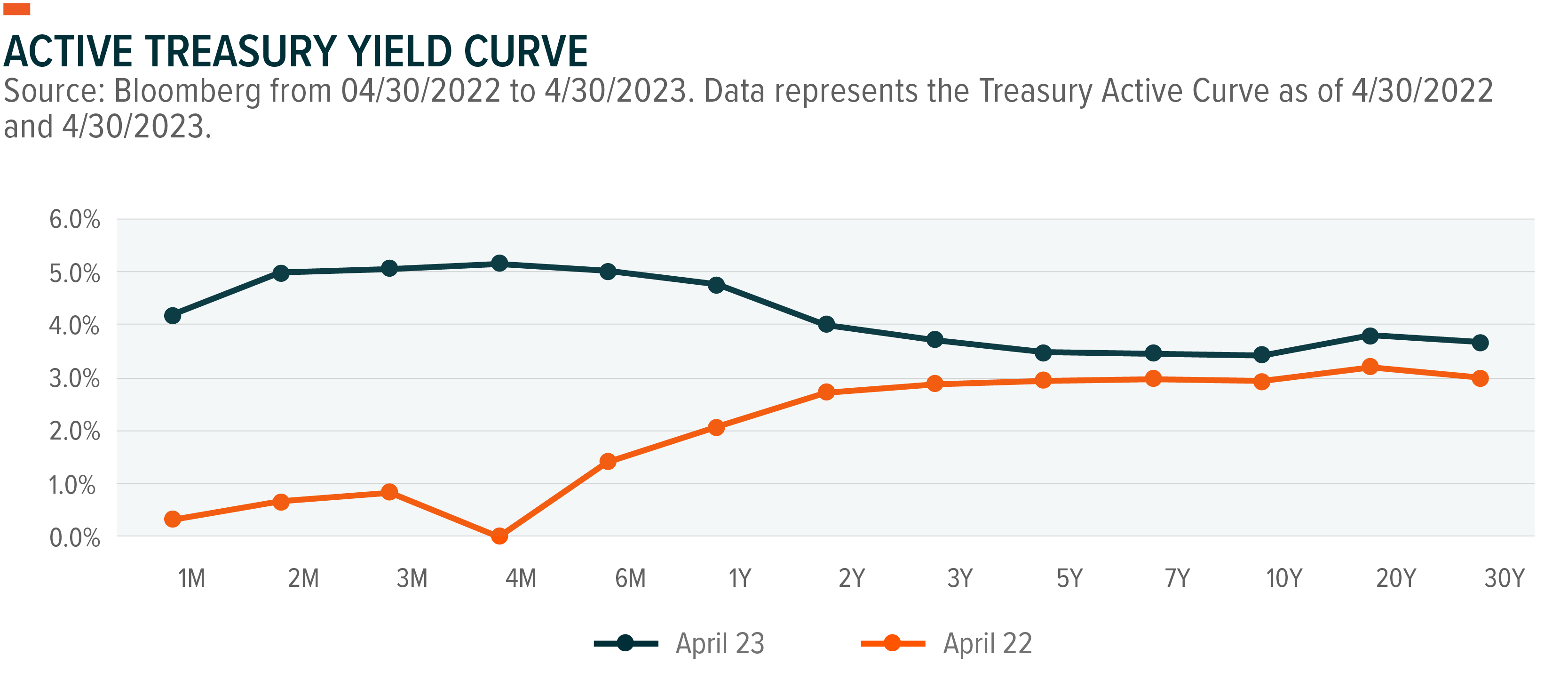
Past performance does not guarantee future results.
As yields have risen in the front end of the Treasury curve, so have asset flows. The chart illustrates that ultrashort bond ETFs have experienced growth in assets under management, driven by an increase in investor demand for investments that offer yield with relatively low volatility. Many ultrashort bond ETFs include securities with embedded credit risk, as they tend to have increased leeway regarding the strategy’s investments. This includes the ability to allocate towards corporate bonds, mortgage-backed securities (MBS), and other securities rated below AAA. The average Ultrashort Treasury ETF only produces a 41.96% weighting towards Treasuries and an 87% weight towards investment-grade securities.8 Outlining, that they may not exclusively focus on short-term Treasuries. This makes the Global X 1-3 Treasury Bill ETF an attractive option for investors seeking an ultra-short bond fund investing primarily in U.S. Treasuries within a transparent, passive ETF structure.
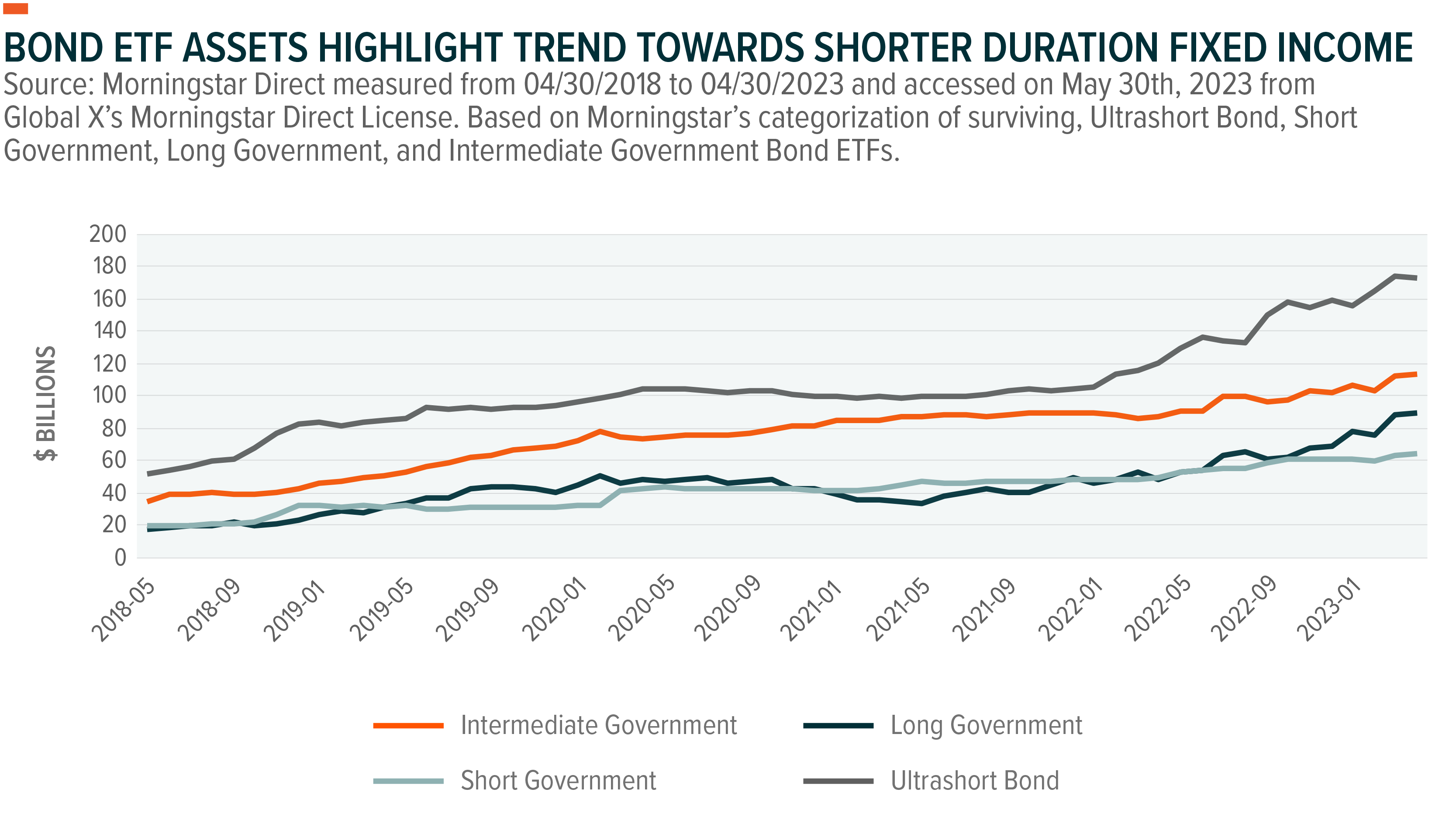
Potential Benefits of Short-Term Treasury ETFs Against Other Cash Alternatives
The trend of investors looking to allocate towards short-term securities has also resulted in the resurgence of interest in money market funds and other short-term investment securities like CDs. While passive treasury ETF strategies provide investors with the exact maturity of the basket of securities, money market funds offer portfolio managers the flexibility to invest in a wide range of assets, including Treasuries with a maturity of up to one-year, commercial paper, municipal bonds, CDs, Eurodollar deposits, and more.9 However, this flexibility comes with a trade-off: a higher expense ratio and added credit risk. As the chart below illustrates, the average money market yield is notably lower than investing in 1-3 month T-Bills. It is essential to note that money market funds typically have a higher expense ratio, with most ranging between 0.2% to 1%, and some being as high as 2.5%.10 Lastly, Money Market Funds may require a minimum invested amount and front-loaded fees making it difficult or more costly to move assets out during a given time.

Past performance does not guarantee future results.
Investors have many options when it comes to choosing ultrashort fixed income ETFs. Whether investing in active or passive management. Global X has decided on the passive front as active strategies tend to have imbedded risks that the investor may not be aware of. For example, many active strategies may achieve a higher yield compared to the passive, this also may come with higher credit risk, as many of the active strategies in the space can include investment exposure towards complex products that may lack liquidity during a market downturn such as commercial mortgage backed-securities (CMBS) or asset-backed securities (ABS). In addition, some of those securities can come with lower credit quality ratings compared to treasuries.
Global X has opted for a passive management approach for their Ultrashort Treasury ETF, recognizing the benefits of a strategy that minimizes fund manager risk while providing a relatively stable and low-cost investment option. The cost-effectiveness of the passive approach is particularly notable when comparing the average expense ratios of active and passive ultrashort bond ETFs. Within this category of ETFs, passive strategies boast an expense ratio that is only 43% of the average active fund, with an average expense ratio of 0.14% and 0.25% respectively.11 With an expense ratio of 0.07%, the Global X T-Bill ETF has an expense ratio half of the average passive ultrashort bond ETF at 0.07%. Given this context, the associated fees of the fund become a significant consideration for Global X. Investor behavior aligns with these factors, as evidenced by the chart below. Notably, investors have predominantly allocated their investments towards passive ultrashort Treasury ETFs, favoring a more transparent investment approach and expressing a desire for lower fees and expenses.
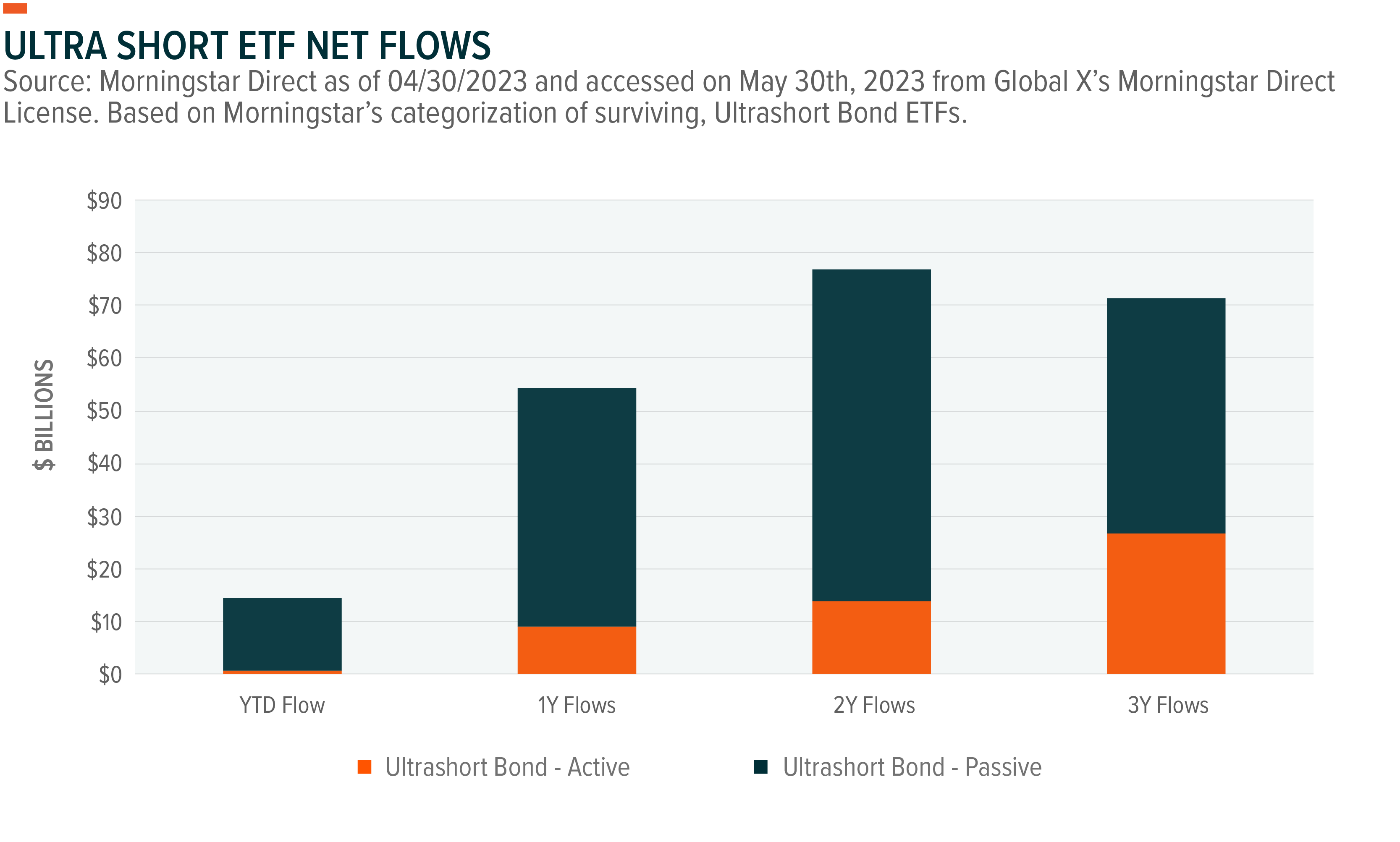
CLIP: An ETF Offering Investment Opportunity for Risk Averse Investors in a Highly Volatile Environment
CLIP is a distinctive ETF that provides investors with exposure to the shortest segment of the treasury curve by targeting Treasury Bills with a maturity of 1-3 months through tracking the Solactive 1-3 Month T-Bill Index. The strategy invests in T-Bills with a maturity of equal to or greater than one month and equal to or less than three months. When an individual T-Bill hits one month or less until maturity, the strategy rolls the T-Bill out of the portfolio. In contrast to Treasury Notes and Bonds, T-bills are zero coupon bonds issued at a discount and redeemed at par upon maturity. Furthermore, the Solactive index excludes inflation-linked bonds, such as Treasury Inflation-Protected Securities (TIPS), making the strategy straight forward and transparent for investors. Other passive T-Bill ETFs may invest in non-traditional treasury securities, such as TIPS, and can have a longer maturity by investing in longer-dated treasuries, which could increase volatility. Therefore, it is vital to fully understand the index methodology when deciding on a T-Bill ETF.
The CLIP ETF is primarily dedicated to investing in USD-denominated T-bills issued by the US Treasury, with a minimum outstanding value of $250 million. This strategic choice ensures that the fund maintains a notable level of liquidity, providing investors with ample ease of entry and exit. Furthermore, each individual component within the portfolio is weighted based on its market value and accrued interest on the selection day, employing a market-cap weighting structure that further enhances the liquidity of the ETF. The straightforward selection process employed by the fund not only contributes to its ease of operation but also offers transparency to the end investor, fostering transparency and clarity.
By offering investors exposure to the shortest segment of the treasury curve, the CLIP ETF presents the potential for a high level of liquidity, which proves especially advantageous for those seeking a cash or liquidity position within their investment portfolio. Moreover, investing in short-term treasuries has the benefit of potentially yielding higher returns compared to the longer part of the curve, while concurrently exhibiting lower volatility. This combination of increased yield, lower volatility, and enhanced liquidity positions the CLIP ETF as an appealing option for investors in search of a relatively stable investment.
Conclusion
In conclusion, the launch of the Global X 1-3 Month T-Bill ETF provides investors with an attractive option for investing in U.S. Treasury bills with shorter maturities. As interest rate risk continues to remain uncertain, short-term treasuries are becoming more appealing due to their lower duration risk and higher yields, on the backdrop of the Fed’s tightening campaign to fight inflation. Short-term treasuries also offer high liquidity and are less sensitive to changes in interest rates, making them a relatively stable investment option in uncertain economic times. The ETF is expected to invest solely in Treasury Bills, making it an attractive option for investors seeking to minimize credit and interest rate risks. It also offers benefits over other cash alternatives such as money market funds by providing an exact maturity of the basket of securities at a lower expense ratio and lower credit risk. Overall, the Global X 1-3 Month T-Bill ETF presents an appealing investment opportunity for investors seeking to mitigate credit risk and maximize yield potential during uncertain times.
Related ETFs
CLIP – Global X 1-3 Month T-Bill ETF
Click the fund name above to view current holdings. Holdings are subject to change. Current and future holdings are subject to risk.
